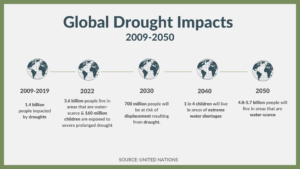In this briefing, we explore global drought conditions and the resulting impacts on people and the economy, as well as steps your business can take to help solve the problem.
Click here to sign up for B’s Briefing – a weekly round-up of recent news you should know.
ARTEMIA has been headquartered in California since 1995, and the team has seen its fair share of droughts. Unfortunately, in recent years the problem has worsened and our beautiful state is now experiencing the driest conditions in 1200 years.
The problem certainly isn’t isolated to the Golden State. Although the Western part of the U.S. continues to be suffering from the most severe conditions, states across the country are drying up. In fact, 44 percent of the U.S. is currently in a drought with 39 states experiencing conditions categorized as “Moderate” or worse.
According to the University of Nebraska’s Drought Monitor, short-term drought conditions are quickly expanding throughout the Ohio, Tennessee, and Middle Mississippi Valleys as well as parts of the corn belt. The North-Eastern part of the nation slid has expanding drought coverage and Alaska is drier than normal.
The Big Picture
These dry conditions are worsening around the globe. Between 2000 and 2019 droughts impacted about 1.4 billion people, according to the United Nations. Today, approximately 3.6 billion people live in water-scarce areas for at least one month out of the year; by 2050 that is expected to increase to 4.8-5.7 billion.
Approximately 160 million children are currently exposed to severe and prolonged droughts, and by 2040, 1 out of 4 children will live in areas of extreme water shortages. For some, 2040 may seem far off in the future, but it is a mere 18 years away – the average age of most U.S. students when they graduate high school.
Furthermore, in the last 40 years, approximately 12 million hectares of land were lost annually due to drought and desertification. This by itself has carried significant consequences for those it has affected.
A Closer Look
On June 7, the European Union warned that this will be one of its most difficult years in the way of natural disasters, due to the increase in wildfires, droughts and other crises connected to Climate Change.
On July 8, the government of Portugal declared an 8-day state of alert due to increased wildfire risk. The country has been dealing with a severe drought and issued the alert in order to give the government temporary authority to order precautionary measures ahead of a heatwave expected to bring temperatures as high as 109 degrees Fahrenheit.
Italy is facing an unprecedented drought that has left the banks of the Po, one of the country’s longest rivers, nearly dry. According to Euronews, the river drives nearly ⅓ of Italy’s agriculture production and many residents rely on the water for domestic use. As of today, water restrictions have been implemented in more than 100 municipalities.
Agriculture is also taking a significant hit in Somalia, which is experiencing its worst drought in 4 decades. Three million livestock have perished and more than 805,000 people have been displaced. According to the United Nations, 7.1 million people – nearly half of the country’s population – are facing acute levels of food insecurity.
In Ethiopia, things have grown so severe that children are being attacked by monkeys. Experts say that this behavior is incredibly unusual, and linked to a widespread food shortage caused by the country’s worst drought in 50 years.
3 Ways to Take Action
Research and set achievable goals
It is important to determine what your company can reasonably achieve. In order to do that, it is essential to gather data. You may be surprised by how much water your company actually uses. When collecting this data, look further than your facility. Are your suppliers practicing efficient water use? Are they making efforts to improve? Use this data to drive decisions regarding what your company will report, the goals you hope to achieve and how you will do so.
Make Necessary Repairs
Don’t wait around to address leaky pipes at home or at work. If we examine household leaks alone, approximately 900 billion gallons of water leak annually in the U.S., according to the EPA – the equivalent of the annual water use of 11 million households.
Invest in some upgrades
Installing low-flow faucets throughout your facility will restrict the amount of water that is emitted each minute. Upgrading to smart meters can also make a significant difference, both in cost and water efficiency.
We can help
Do you need assistance in creating a water efficiency plan or reporting your progress? Do you have a solution that will help other companies reach their goals? Please get in touch with us by calling (415) 351-2227 or emailing kamie@artemiadev.wpengine.com.
Don’t forget to subscribe to B’s Briefing!







